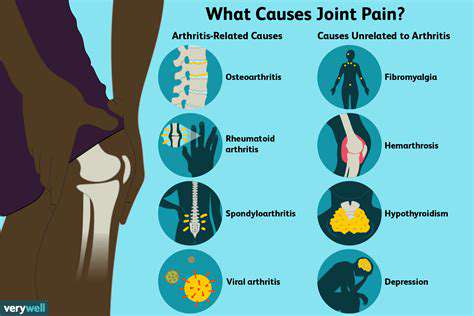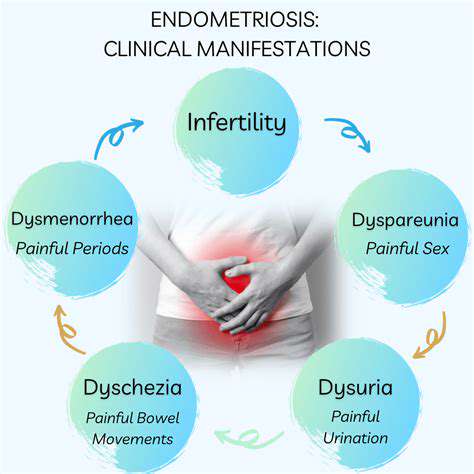Common Causes of Pain, Stiffness, and Inflammation

Understanding the Underlying Conditions
Joint pain, stiffness, and inflammation can be associated with various underlying conditions, such as arthritis, bursitis, and tendinitis. Understanding the origin of these symptoms is crucial for effective treatment and management. Each condition has distinct causes and may require different therapeutic approaches.
Arthritis, for instance, is a common ailment that leads to the deterioration of joint cartilage. This degradation often results in chronic pain, reducing mobility and significantly impacting daily activities. Recognizing these conditions early can lead to better outcomes and improved quality of life.
Effects on Physical Mobility
The presence of joint pain and stiffness can greatly limit a person's ability to engage in physical activities. Simple tasks such as walking, bending, or climbing stairs can become daunting challenges. This limitation often leads to a sedentary lifestyle, which can further exacerbate health issues.
Furthermore, the pain often leads to altered posture and walking patterns, which can create additional strain on other body parts. Over time, this may lead to a cycle of pain and further degeneration, emphasizing the importance of timely intervention.
Mental and Emotional Impact
The impact of joint issues extends beyond the physical realm, seriously affecting mental and emotional health. Chronic pain can lead to frustration, anxiety, and even depression as individuals struggle to cope with the limitations imposed on their lives. The psychological burden often goes hand in hand with physical symptoms, creating a complex health challenge.
Support systems are vital for individuals dealing with these issues. Engagement in support groups or therapy can provide emotional relief and practical strategies for managing pain and improving overall well-being. Balancing physical and mental health is integral to dealing with the symptoms and enhancing the quality of life.
Recognizing Symptoms and Their Impact

Understanding Joint Pain
Joint pain affects millions of people worldwide, ranging from mild discomfort to severe pain that limits mobility. It can stem from various conditions such as arthritis, injuries, or overuse of joints. Recognizing the early signs of joint pain is crucial for timely intervention and management. Symptoms can vary widely, with some experiencing sharp pain during movement, while others may feel a constant ache. Additionally, joint pain often goes hand in hand with swelling, making it vital to monitor changes in joint appearance.
For many, chronic joint pain can lead to emotional stress and anxiety. When everyday activities become challenging, it can diminish one’s quality of life. Understanding the underlying causes can empower individuals to seek appropriate medical help. Early diagnosis can lead to effective treatment plans that address not only the physical but also the psychological aspects of joint pain.
In addition to physical pain, joint issues can lead to secondary conditions like muscle atrophy due to decreased mobility. A sedentary lifestyle, driven by pain, can exacerbate the situation, leading to a cycle of worsening symptoms. It is important to maintain some level of physical activity, as recommended by healthcare professionals, to alleviate stiffness and promote joint health.
Moreover, joint pain can interfere with sleep patterns. Many individuals find it difficult to find a comfortable sleeping position, leading to insomnia or disrupted sleep. This lack of rest can further complicate the management of chronic pain. Recognizing and addressing sleep disturbances caused by joint pain is essential in achieving overall well-being.
Lastly, joint pain episodes can be unpredictable, creating anxiety about engaging in social activities. Many individuals may isolate themselves to avoid potential embarrassment or discomfort. Consequently, fostering supportive environments and understanding among friends and family can help those suffering from joint pain lead more fulfilling lives.
Identifying Stiffness and Its Effects
Joint stiffness is often one of the first signs of underlying joint problems. This stiffness can occur after periods of inactivity or upon waking, making it challenging to initiate movement. Identifying stiffness early can assist in determining the specific type of joint issue present. It is essential for individuals to observe their symptoms closely, as variations in stiffness can indicate different health concerns.
In many cases, joint stiffness leads to decreased range of motion, which can affect everyday tasks such as dressing, cooking, or exercising. When simple movements become arduous, it can significantly impact one's independence and daily routine. Finding adaptive strategies or using assistive devices can help individuals regain some independence and manage stiffness effectively.
Furthermore, stiffness can create a psychological burden, often leading to frustration or feelings of helplessness. Individuals may become discouraged if they cannot perform activities they once enjoyed. Providing emotional support and encouragement from loved ones is vital in helping those affected cope with stiffness. Connecting with support groups or engaging in group activities can also foster a sense of community and shared experience.
Incorporating regular stretching and low-impact exercises can help alleviate stiffness. Activities such as yoga or tai chi have been shown to improve flexibility and reduce stiffness in joints. It is important to consult a healthcare provider before starting any new exercise routine to ensure it aligns with one's health needs.
Moreover, stiffness can also lead to compensatory movements, putting strain on other joints or muscles. This can create a cascading effect, where pain and discomfort extend beyond the initially affected area. Proactively addressing stiffness can help prevent these further complications and promote better overall joint health. Understanding how joint health interrelates can guide individuals toward better management practices.
The Role of Inflammation in Joint Health
Inflammation is a natural response of the body to injury or infection, but chronic inflammation can severely impact joint health. Conditions like rheumatoid arthritis are characterized by persistent inflammation, leading to pain and joint damage. Understanding the role of inflammation is essential for anyone dealing with joint-related issues. Managing this inflammation often requires a multifaceted approach that includes diet, exercise, and medication.
Anti-inflammatory diets, rich in omega-3 fatty acids, fruits, and vegetables, can play a significant role in reducing joint inflammation. Foods such as fatty fish, nuts, and berries have been proven to lower inflammatory markers in the body. Consulting a nutritionist can help tailor an anti-inflammatory diet that suits individual preferences and health conditions. This proactive dietary change can lead to noticeable improvements in joint comfort and functionality.
Additionally, engaging in regular physical activity is crucial for managing inflammation. Low-impact activities, such as swimming or cycling, can enhance blood flow and reduce swelling in the joints without causing further strain. It is essential to seek guidance from a healthcare provider to ensure that chosen activities are appropriate and safe.
Mindfulness and stress-reduction techniques can further assist in managing inflammation. Stress can exacerbate inflammation, making it crucial to find effective coping strategies. Practices such as meditation, deep breathing, and yoga can be beneficial in reducing stress levels and, consequently, inflammatory responses.
Lastly, staying informed about current treatments and therapies for managing inflammation, such as physical therapy or medications, can enhance overall joint health. Open communication with healthcare providers allows individuals to explore various options that align with their treatment goals. Taking an active role in managing inflammation can lead to improved joint health and a better quality of life.
Living with Joint Pain, Stiffness, and Inflammation
Living with joint pain, stiffness, and inflammation requires proactive management and lifestyle adjustments. Developing a personalized care plan that incorporates medical treatments, exercise, and dietary choices is critical. This individualized approach can help mitigate the impact of these symptoms on daily life. Regular check-ups with healthcare providers ensure that the management plan evolves as needs change.
Incorporating wellness practices into everyday routines can also play a pivotal role in maintaining joint health. Practices such as warm baths, hot/cold therapy, and massage can provide immediate relief from pain and stiffness. Establishing these routines not only aids physical comfort but can also serve as a mental health boost. Small self-care rituals contribute to an overall sense of well-being.
Furthermore, community support can be immensely beneficial. Joining support groups or engaging in community activities can foster relationships with others who understand the challenges associated with joint issues. Sharing experiences and strategies can provide new insights and encouragement, making individuals feel less isolated in their struggles.
It’s also essential to remain adaptable and open-minded about treatment options. As research advances, new therapies and medications become available that could offer relief. Staying informed and willing to try out new approaches can make a significant difference in managing symptoms.
Overall, the journey of managing joint pain, stiffness, and inflammation is a personal one that requires patience and perseverance. Acknowledging the impact that these conditions have on life is the first step toward reclaiming control. By developing comprehensive management strategies that combine medical, dietary, and emotional support, individuals can lead fulfilling lives despite their challenges.
Management and Treatment Options
Understanding the Challenges of Joint Pain
Joint pain affects millions of individuals worldwide, leading to significant discomfort and limitations in mobility. This discomfort can manifest as sharp pain, a dull ache, or even a persistent throbbing sensation, varying in intensity throughout the day.
The impact of joint stiffness is particularly notable in the morning or after prolonged periods of inactivity, making it difficult to start the day or resume activities after sitting for a while. This stiffness can contribute to a secondary fear of movement, leading to a cycle of reduced physical activity.
Inflammation associated with joint pain can exacerbate the situation, as the body’s natural response to injury or irritation can cause swelling, redness, and increased pain. This inflammation can lead to decreased joint function, making everyday tasks such as walking, climbing stairs, or even gripping objects a challenge.
Moreover, the emotional toll of chronic joint pain cannot be overlooked. Individuals often experience feelings of frustration, anxiety, and depression, particularly when the pain interferes with their ability to engage in social activities or fulfill their personal and professional responsibilities.
Exploring Management and Treatment Strategies
Managing joint pain effectively requires a comprehensive approach that can include both medical treatment and lifestyle changes. Initial steps often involve over-the-counter medications such as non-steroidal anti-inflammatory drugs (NSAIDs) to help alleviate pain and reduce inflammation.
Physical therapy is another vital component of management, as it focuses on strengthening the muscles surrounding the joints, improving flexibility, and enhancing overall mobility. A well-designed therapy program can empower individuals to regain control over their physical abilities.
In addition to medical and therapeutic interventions, lifestyle changes play a crucial role in managing joint pain. Maintaining a balanced diet rich in anti-inflammatory foods, staying well-hydrated, and incorporating regular, low-impact exercise can significantly improve symptoms.
For more severe cases, advanced treatments, such as corticosteroid injections or even surgical options, might be considered. The choice of treatment is often tailored to the individual's specific condition and severity of symptoms, ensuring a personalized approach to achieving a better quality of life.